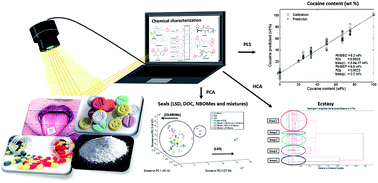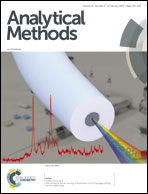Portable near infrared spectroscopy applied to abuse drugs and medicine analyses†
Abstract
Near infrared (NIR) spectroscopy using a portable instrument (microNIR) associated with chemometrics models (partial least squares regression (PLS), principal component analysis (PCA) and hierarchical cluster analysis (HCA)) was applied to quantify cocaine, and to classify synthetic drugs by their functional chemical composition in 19 ecstasy tablets, 22 seals of designer drugs and 23 medicine samples. Cocaine content in the range of 0 to 100 wt% was quantified by PLS model with root mean square error of prediction of 6 wt%. Then, the PLS model was applied in 38 seized cocaine samples and the results were compared to results from liquid chromatography with a diode array detector. MicroNIR spectroscopy was able to discriminate between the seal samples between LSD and NBOMes derivatives, while for the ecstasy tablets, five groups were formed containing (1) MDMA; (2) amphetamine, ATS, methamphetamine, MDMA, 2C–B; (3) amphetamine and caffeine; (4) MDMA; and (5) ethylone and ketamine. Finally, the results of the medicine analysis indicated either a lack of quality control (with distinct dosages other than specified on the packaging) or falsification.



 Please wait while we load your content...
Please wait while we load your content...